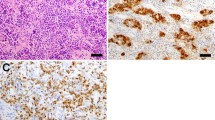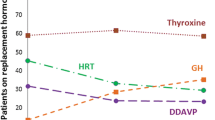Abstract
Purpose
To explore the potential role of focused radiotherapy in managing the lymphocytic hypophysitis (LH) refractory to medical therapy and surgery.
Method
A systematic literature review was conducted following PRISMA guidelines to identify the studies on radiation treatment for hypophysitis, along with the experience in our institution.
Results
The study included eight patients, three from our institution and five from existing literature. The age at presentation ranged from 37 to 75 years old, with a median age of 58. The presenting symptoms involved headache in seven patients and diplopia in two patients. Pre-radiation visual field defects were noticed in four patients. All patients exhibited variable degrees of hypopituitarism before radiation, with oral corticosteroids being the initial medical treatment. Immunosuppressive therapy was attempted in two patients prior to radiation. Seven patients had a history of transsphenoidal surgery with a histologically confirmed LH. Three patients underwent stereotactic radiosurgery (SRS), while the remaining received FSRT, with a mean irradiation volume of 2.2 cm3. A single-session total dose of 12 -15 Gy was administered in the SRS group. In the FSRT group, doses ranged from 24 to 30 Gy with a median dose of 25 Gy, delivered in 2 Gy fractions. Four patients achieved a resolution of visual field defects, while another two patients demonstrated improvement in their associated focal neurologic deficits. No change in pre-existing endocrine status was shown after radiation, except in one patient. Clinical response was achieved in seven patients after a single course of radiation, while one patient required the second course. Six patients remained stable on low-dose glucocorticoid during at least a 12-month follow-up period, and one discontinued it entirely without experiencing relapse. Three patients demonstrated a complete radiologic response, while the remaining showed a partial radiologic response.
Conclusions
Focused radiation, including FSRT, can play a role in symptomatic relief, effective mass shrinkage, and minimizing radiation exposure to critical surrounding structures in patients with refractory LH. However, further research efforts are necessary to better clarify its effects and optimal dose planning.







Similar content being viewed by others
Data availability
It is not applicable.
References
Ray DK et al (2010) Gamma knife surgery for lymphocytic hypophysitis. J Neurosurg 112(1):118–121
Leung GK et al (2004) Primary hypophysitis: a single-center experience in 16 cases. J Neurosurg 101(2):262–271
Minakshi B, Alok S, Hillol KP (2005) Lymphocytic hypophysitis presenting as pituitary apoplexy in a male. Neurol India 53(3):363–364
Bensing S et al (2007) Lymphocytic hypophysitis: report of two biopsy-proven cases and one suspected case with pituitary autoantibodies. J Endocrinol Invest 30(2):153–162
Yamagami K et al (2003) Treatment of lymphocytic hypophysitis by high-dose methylprednisolone pulse therapy. Intern Med 42(2):168–173
Selch MT et al (2003) Stereotactic radiotherapy for the treatment of lymphocytic hypophysitis. Rep Two Cases J Neurosurg 99(3):591–596
Donaldson SS et al (1980) Treatment of orbital pseudotumor (idiopathic orbital inflammation) by radiation therapy. Int J Radiat Oncol Biol Phys 6(1):79–86
Keleti D et al (1992) Radiotherapy of lymphoproliferative diseases of the orbit. Surveillance of 65 cases. Am J Clin Oncol 15(5):422–427
Conn DL (2001) Resolved: Low-dose prednisone is indicated as a standard treatment in patients with rheumatoid arthritis. Arthritis Rheum 45(5):462–467
Gubbi S et al (2019) Hypophysitis: an update on the novel forms, diagnosis and management of disorders of pituitary inflammation. Best Pract Res Clin Endocrinol Metab 33(6):101371
Angelousi A et al (2018) Clinical, endocrine and imaging characteristics of patients with primary hypophysitis. Horm Metab Res 50(4):296–302
Chalan P, Thomas N, Caturegli P (2021) Th17 cells contribute to the pathology of autoimmune hypophysitis. J Immunol 206(11):2536–2543
Langlois F, Varlamov EV, Fleseriu M (2021) Hypophysitis, the growing spectrum of a rare pituitary disease. J Clin Endocrinol Metab 107(1):10–28
Di Dalmazi G et al (2019) Hypophysitis induced by immune checkpoint inhibitors: a 10-year assessment. Expert Rev Endocrinol Metab 14(6):381–398
Pekic S et al (2018) Lymphocytic hypophysitis successfully treated with stereotactic radiosurgery: case report and review of the literature. J Neurol Surg A Cent Eur Neurosurg 79(1):77–85
Hendrickx A, Bossuyt X (2001) Quantification of the leukocyte common antigen (CD45) in mature B-cell malignancies. Cytometry 46(6):336–339
Lee EJ et al (2017) CD3 and CD20 immunohistochemical staining patterns of bone marrow-infiltrating malignant lymphoma cells. Ann Clin Lab Sci 47(2):136–143
O’Connell FP, Pinkus JL, Pinkus GS (2004) CD138 (syndecan-1), a plasma cell marker immunohistochemical profile in hematopoietic and nonhematopoietic neoplasms. Am J Clin Pathol 121(2):254–263
Lecube A et al (2003) Lymphocytic hypophysitis successfully treated with azathioprine: first case report. J Neurol Neurosurg Psychiatry 74(11):1581–1583
Schreckinger M et al (2012) Novel strategy to treat a case of recurrent lymphocytic hypophysitis using rituximab. J Neurosurg 116(6):1318–1323
Gubbi S et al (2018) Primary hypophysitis and other autoimmune disorders of the sellar and suprasellar regions. Rev Endocr Metab Disord 19(4):335–347
Honegger J et al (2015) Treatment of primary hypophysitis in Germany. J Clin Endocrinol Metab 100(9):3460–3469
Fitzpatrick PJ, Macko S (1984) Lymphoreticular tumors of the orbit. Int J Radiat Oncol Biol Phys 10(3):333–340
Biswas R et al (2020) Inflammatory myofibroblastic tumor of maxillary sinus successfully treated with radiotherapy and corticosteroid: report of a rare case. J Egypt Natl Canc Inst 32(1):26
Najjar N et al (2022) Very low-dose radiation therapy for management of inflammatory myofibroblastic tumor of the lung. Rare Tumors 14:20363613221106270
Minniti G et al (2014) Fractionated stereotactic radiosurgery for patients with brain metastases. J Neurooncol 117(2):295–301
Sallabanda K et al (2011) Stereotactic radiosurgery in pituitary adenomas: long-term single institution experience and role of the hypothalamic-pituitary axis. J Radiosurg SBRT 1(3):213–220
Minniti G et al (2016) Stereotactic radiotherapy and radiosurgery for non-functioning and secreting pituitary adenomas. Rep Pract Oncol Radiother 21(4):370–378
Carvalho HA, Villar RC (2018) Radiotherapy and immune response: the systemic effects of a local treatment. Clinics (Sao Paulo) 73(suppl 1):e557s
Tripathi M et al (2021) Role of stereotactic radiosurgery in intracranial histiocytosis: a systematic review of literature of an emerging modality for localized disease. World Neurosurg 150:64–70
Kuntz L et al (2022) Radionecrosis after repeated courses of radiotherapy under stereotactic conditions for brain metastases: analysis of clinical and dosimetric data from a retrospective cohort of 184 patients. Cancer Radiother 26(5):692–702
Moreau J et al (2018) Second course of stereotactic radiosurgery for locally recurrent brain metastases: Safety and efficacy. PLoS ONE 13(4):e0195608
Sheehan JP et al (2005) Stereotactic radiosurgery for pituitary adenomas: an intermediate review of its safety, efficacy, and role in the neurosurgical treatment armamentarium. J Neurosurg 102(4):678–691
Funding
There was no financial or funding support for the project
Author information
Authors and Affiliations
Contributions
Data collection: MK, GF, and VM. Literature review and data interpretation: MK and GF. Writing: MK. Figure preparation: MK, GF, PK, DB, VM, KD Critical review and final approval: all authors
Corresponding author
Ethics declarations
Conflicts of interest
Dr. Daniel Prevedello is a consultant for Stryker Corp., Medtronic Corp., BK Medical and Integra; he has received an honorarium from Mizuho and royalties from KLS- Martin and ACE Medical. All other authors do not have conflict of interest to report.
Additional information
Publisher's Note
Springer Nature remains neutral with regard to jurisdictional claims in published maps and institutional affiliations.
This paper abstract has been selected to be presented in the Congress of Neurological Surgeon (CNS) in September 2023. The authors declare that this manuscript is a unique submission and has not been published in whole or in part elsewhere in any form.
Rights and permissions
About this article
Cite this article
Khaleghi, M., Finger, G., Wu, K.C. et al. Successful treatment of medically and surgically refractory lymphocytic hypophysitis with fractionated stereotactic radiotherapy: a single-center experience and systematic literature review. Pituitary 27, 213–229 (2024). https://doi.org/10.1007/s11102-023-01367-8
Accepted:
Published:
Issue Date:
DOI: https://doi.org/10.1007/s11102-023-01367-8




